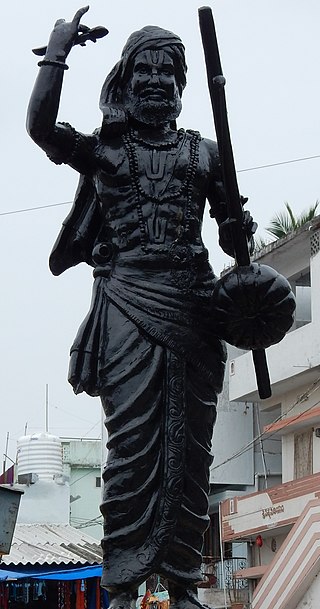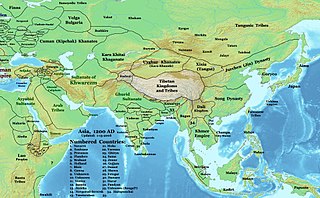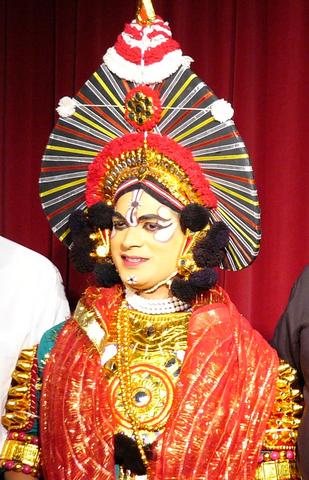
Basaveshwara, colloquially known as Basavanna, was a 12th-century CE Indian statesman, philosopher, poet, Lingayat social reformer in the Shiva-focussed bhakti movement, and a Hindu Shaivite social reformer during the reign of the Kalyani Chalukya/Kalachuri dynasty. Basava was active during the rule of both dynasties but reached the peak of his influence during the rule of King Bijjala II in Karnataka, India.

Kannada literature is the corpus of written forms of the Kannada language, a member of the Dravidian family spoken mainly in the Indian state of Karnataka and written in the Kannada script.

Yakshagaana is a traditional theatre, developed in Dakshina Kannada, Udupi, Uttara Kannada, Shimoga and western parts of Chikmagalur districts, in the state of Karnataka and in Kasaragod district in Kerala that combines dance, music, dialogue, costume, make-up, and stage techniques with a unique style and form. It is believed to have evolved from pre-classical music and theatre during the period of the Bhakti movement. It is sometimes simply called "Aata" or āṭa. This theatre style is mainly found in coastal regions of Karnataka in various forms. Towards the south from Dakshina Kannada to Kasaragod of Tulu Nadu region, the form of Yakshagana is called Thenku thittu and towards the north from Udupi up to Uttara Kannada it is called Badaga thittu. Both of these forms are equally played all over the region.(Not sure about this one but) Yakshagana is traditionally presented from dusk to dawn. Its stories are drawn from Ramayana, Mahabharata, Bhagavata and other epics from both Hindu and Jain and other ancient Indic traditions.

Telugu literature is the body of works written in the Telugu language. It consists of poems, short stories, novels, plays, and song lyrics, among others. There is some indication that Telugu literature dates at least to the middle of the first millennium, the first extant works are from the 11th century when the Mahabharata was first translated to Telugu from Sanskrit by Nannaya. The language experienced a golden age under the patronage of the Vijayanagara king-poet Krishnadevaraya.

Kancharla Gopanna, popularly known as Bhakta Ramadasu or Bhadrachala Ramadasu, was a 17th-century devotee of the Hindu god Rama, a saint-poet and a composer of Carnatic music. He is a famous Vaggeyakara from the Telugu classical era. He was born in the village of Nelakondapalli in Khammam district, and orphaned as a teenager. He spent his later years in Bhadrachalam and 12 years in solitary confinement at the Golconda prison during the Qutb Shahi-rule. Different mythical stories about his life circulate in the Telugu tradition. He is renowned for constructing the famous Sita Ramachandraswamy Temple and pilgrimage center on the banks of river Godavari at Bhadrachalam. His devotional kirtana lyrics to Rama illustrate the classical Pallavi, Anupallavi and Caranam genre composed mostly in Telugu, some in Sanskrit and with occasional use of Tamil language. These are famous in South Indian classical music as Ramadaasu Keertanalu.

H. R. Keshava Murthy was an Indian gamaka exponent and guru. He was honoured with Shantala Natya Sri Award by the Government of Karnataka in 1998 and Padma Shri in 2022 by the Government of India in the field of arts.

Vijayanagara literature was produced in the Vijayanagara Empire during a golden age of literature in South India in general. The rulers patronised Kannada, Telugu, Sanskrit and Tamil scholars who wrote in the Jain, Virashaiva and Vaishnava traditions. The period produced hundreds of works on all aspects of Indian culture, religion, biographies, Prabhandas (stories), music, grammar, poetics and medicine. An attempt is made in this section to list the various poets and saints and their most famous works.
Tala-Maddale is an ancient form of performance dialogue or debate performance in Southern India in the Karavali and Malnad regions of Karnataka and Kerala. The plot and content of the conversation is drawn from popular mythology but the performance mainly consists of an impromptu debate between characters involving sarcasm, puns, philosophy positions and humour. The main plot is sung from the same oral texts used for the Yakshgana form of dance- drama. Performers claim that this was a more intellectual rendition of the dance during the monsoon season.

Harikatha, also known as Harikatha Kaalakshepam in Telugu and Tamil, is a form of Hindu traditional discourse in which the storyteller explores a traditional theme, usually the life of a saint or a story from an Indian epic. The person telling the story through songs, music and narration is called a Haridasa.

Hoysala literature is the large body of literature in the Kannada and Sanskrit languages produced by the Hoysala Empire (1025–1343) in what is now southern India. The empire was established by Nripa Kama II, came into political prominence during the rule of King Vishnuvardhana (1108–1152), and declined gradually after its defeat by the Khalji dynasty invaders in 1311.

The southern state of India,Karnataka, has a distinct art and culture informed by a long history of diverse linguistic and religious ethnicity. Apart from Kannadigas, Karnataka is home to Tuluvas, who also consider themselves as Kannadigas. Minor populations of Tibetan Buddhists and Siddhi tribes plus a few other ethnic groups also live in. The traditional folk arts are major theatrical forms of coastal Karnataka. Contemporary theatre culture in Karnataka is one of the most vibrant in India with organizations like Ninasam, Ranga Shankara and Rang on foundations laid down by the Gubbi Veeranna Nataka Company. Veeragase, Kamsale and Dollu Kunitha are popular dance forms. Bharatanatya also enjoys wide patronage in Karnataka.
Katha is an Indian style of religious storytelling, performances of which are a ritual event in Hinduism. It often involves priest-narrators who recite stories from Hindu religious texts, such as the Puranas, the Ramayana or Bhagavata Purana, followed by a commentary (Pravachan). Kathas sometimes take place in households, involving smaller stories related to the Vrat Katha genre. The didactic Satyanarayan and Ramayana kathas instill moral values by revealing the consequences of human action (karma).
Medieval Kannada literature covered a wide range of subjects and genres which can broadly be classified under the Jain, Virashaiva, Vaishnava and secular traditions. These include writings from the 7th century rise of the Badami Chalukya empire to the 16th century, coinciding with the decline of Vijayanagara Empire. The earliest known literary works until about the 12th century CE were mostly authored by the Jainas along with a few works by Virashaivas and Brahmins and hence this period is called the age of Jain literature,. The 13th century CE, to the 15th century CE, saw the emergence of numerous Virashaiva and Brahminical writers with a proportional decline in Jain literary works. Thereafter, Virashaiva and Brahmin writers have dominated the Kannada literary tradition. Some of the earliest metres used by Jain writers prior to 9th century include the chattana, bedande and the melvadu metres, writings in which have not been discovered but are known from references made to them in later centuries. Popular metres from the 9th century onwards when Kannada literature is available are the champu-kavyas or just champu, vachanasangatya, shatpadi, ragale, tripadi, and kavya.

Balappa Hukkeri (1911–1992) was a singer of folk songs and Bhavageetes in Kannada language and a freedom fighter in his early years. He is mainly credited for popularizing Sugama Sangeetha in North Karnataka, just like P. Kalinga Rao who popularized the art form in South Karnataka. Several prestigious awards have been conferred to him including Sangeet Natak Academy award and "Karnataka Sangeeta Nataka Academy Award". Balappa was fondly called as ‛Saavira Haadugala Saradara’.

Mysore literature in Kannada is a body of literature composed in the Kannada language in the historical Kingdom of Mysore in Southern India and written in the Kannada script. The writings date from the Kingdom of Mysore, which existed from around 1600 CE until the establishment of modern India in 1947. Many of the works of this literature written on religious themes are labeled Veerashaiva or Vaishnava in acknowledgment of the two faiths that gave form to the literature and fostered it until the advent of the modern era. Despite a gradual decline in the popularity of Jainism, authors devoted to the faith produced some works of merit. Secular themes dealing with a wide range of subjects were also written on. Kannada literature flourished for a short while in the court of the neighbouring kingdom of the Nayakas of Keladi whose territory was annexed by Mysore in 1763.

Krishnaraja Wadiyar III was the twenty-second maharaja of the Kingdom of Mysore. Also known as Mummadi Krishnaraja Wadiyar, the maharaja belonged to the Wadiyar dynasty and ruled the kingdom for nearly seventy years, from 30 June 1799 to 27 March 1868. He is known for his contribution and patronage to different arts and music during his reign. He was succeeded by his adopted son, Chamarajendra Wadiyar X.

Vijayanagara literature in Kannada is the body of literature composed in the Kannada language of South India during the ascendancy of the Vijayanagara Empire which lasted from the 14th through the 16th century. The Vijayanagara empire was established in 1336 by Harihara I and his brother Bukka Raya I. Although it lasted until 1664, its power declined after a major military defeat by the Shahi Sultanates in the battle of Talikota in 1565. The empire is named after its capital city Vijayanagara, whose ruins surround modern Hampi, now a World Heritage Site in Karnataka.
Yakshagana rāga refers to melodic modes used in Yakshagana. It is based on pre-classical melodic forms that consist of a series of five or more musical notes upon which a melody is founded. Yakshagana rāgas have indigenous rāgas and others derived from other forms of music. Rāgas in yakshagana are closely associated with a set of melodic forms called mattu. Yakshagana rāgas have their own gamaka. Although yakshagana rāgas share names with rāgas in other Indian music systems, they are compositionally different, with a few exceptions. More than 80 rāgas have been identified to have survived the onslaught of popular and elite musical systems. In Yakshagana tradition, rāgas are associated with different times of the night throughout which Yakshagana is performed.
Gamaka Vidwan M S Ananthapadmanabha Rao was a Kannada poet, writer and gamaki. He was the author of the magnum opus Karnata Bharatha Kathamanjari containing the last eight parvas of the Kannada translation of the Mahabharatha that Kumaravyasa had left unfinished.












